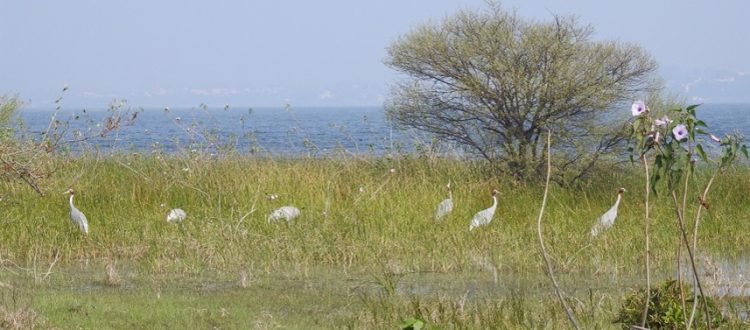Community Conservation Enables Increase in Sarus numbers in Bhoj Wetlands
Community led conservation is key to the protection of wildlife habitats and species across the country. At the Bhoj wetlands in Bhopal, Madhya Pradesh, farmer-led groups by the name of “Sarus Mitra” have been working towards bringing the world’s tallest flying birds back to this Ramsar site.
Sarus in the Bhoj Wetlands
The Sarus crane (Antigone antigone), a resident of India, is the tallest flying bird in the world. The first country-wide survey (1989) of the Indian sarus crane estimated the population to be about 13,000 individuals with Gujarat and Uttar Pradesh as their stronghold.

The first survey of birds including Sarus crane in Bhoj Wetland (Ramsar site of Madhya Pradesh) done by Dr. B.C. Choudhary in 2001 reported a congregation of more than 121 Sarus cranes. However, the population had been rapidly decreasing in the last decade and only two pairs were accounted for by the end of 2010.
Conservation action
WTI’s Rapid Action Project (RAP) for the protection of sarus cranes in Bhoj wetlands was established in 2013 to support local groups, led by the farming community. In the last decade, this collaborative effort has led to the sarus numbers stabilizing from a mere 24 birds in 2013 to a healthy population of 330 individuals today.

Community conservation through Sarus Mitra
The first phase of WTI’s Rapid Action Project (RAP) in 2013, included sensitising the local community, monitoring of population and safeguarding of nests with the help of community volunteers called “Sarus Mitra”. The project was coordinated by Dr. Sangeeta Rajgir (Bhopal Birds Conservation Society). It started from two peripheral villages of Bhoj wetland called Bishankhedi and Goragaon. Regular awareness programmes on threats to sarus cranes promoted the use of organic pesticides and manure. Farmers took to organic farming to safeguard the sarus and their nests. Thanks to the efforts of Sarus Mitra, a noteworthy population of Sarus crane was again established in the Bhoj wetlands.

The project also established the Sarus Biodiversity Education Center in Barkheda Nathu for exchange of experience and knowledge about threats and nesting of sarus crane between rural and urban people. Around 100 Sarus Mitra volunteers from two of these villages observed 24 individual cranes in 2013. Through regular monitoring and continued campaigns, they were able to extend the awareness in other neighbouring villages.
Phase 2 – Sarus Mitra
The project is currently being extended to five more villages (Nathu Barkheda, Beelkheda, Mugaliachhap, Lakhapur and Intkhedichap) of Bhoj wetland area. The project is coordinated by Mr. Mohd. Khalique from Bhopal Birds Conservation Society. The team has already conducted 10 awareness programs and 35 small meetings across the villages. A Total of 673 villagers participated in these programs and about 195 sarus cranes have been observed during this period.

The steady rise of the sarus population to 330 individuals from only 24 in Bhoj Wetland area is a major outcome of concerted community efforts. The forest department too has pitched in for the conservation of these beautiful birds in the landscape.
About the author:
Bhopal Birds Conservation Society has been working on the protection and conservation of the Sarus crane in Bhoj wetlands since 2013. As our on-ground partner, they have been bringing together communities and conservation, using both scientific and social interventions in the landscape.
__________________________________________________________
WTI’s Rapid Action Projects are our key outreach initiatives through which we partner with committed individuals and grassroots agencies to address conservation problems needing immediate attention. Donate here to help us do more.









